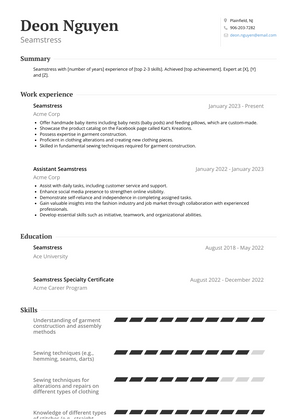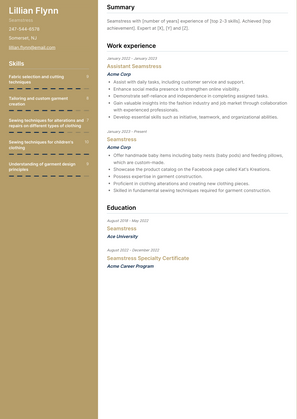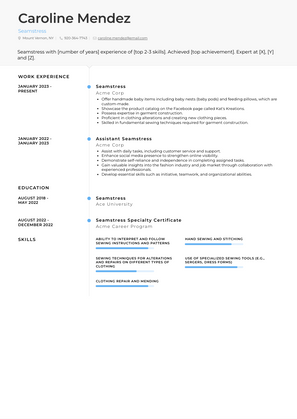Seamstress Resume Examples and Templates
This page provides you with Seamstress resume samples to use to create your own resume with our easy-to-use resume builder. Below you'll find our how-to section that will guide you through each section of a Seamstress resume.



What Do Hiring Managers Look for in a Seamstress Resume
- Proficient in sewing, altering, and repairing garments and other fabric items.
- Strong knowledge of different sewing techniques, patterns, and garment construction.
- Skilled in taking accurate measurements, fitting garments, and making necessary adjustments.
- Ability to work with various types of fabrics and sewing machines, ensuring quality and precise stitching.
- Proficiency in interpreting and following sewing instructions and patterns to create desired designs.
How to Write a Seamstress Resume?
To write a professional Seamstress resume, follow these steps:
- Select the right Seamstress resume template.
- Write a professional summary at the top explaining your Seamstress’s experience and achievements.
- Follow the STAR method while writing your Seamstress resume’s work experience. Show what you were responsible for and what you achieved as a Seamstress.
- List your top Seamstress skills in a separate skills section.
How to Write Your Seamstress Resume Header?
Write the perfect Seamstress resume header by:
- Adding your full name at the top of the header.
- Add a photo to your resume if you are applying for jobs outside of the US. For applying to jobs within the US, avoid adding photo to your resume header.
- Add your current Seamstress position to the header to show relevance.
- Add your current city, your phone number and a professional email address.
- Finally, add a link to your portfolio to the Seamstress resume header. If there’s no portfolio link to add, consider adding a link to your LinkedIn profile instead.
Bad Seamstress Resume Example - Header Section
Valentin 696 Rock Maple St. South Lyon, MI 48178 Marital Status: Married, email: cooldude2022@gmail.com
Good Seamstress Resume Example - Header Section
Valentin Ross, Lyon, MI, Phone number: +1-555-555-5555, Link: linkedin/in/johndoe
Make sure to add a professional looking email address while writing your resume header. Let’s assume your name is John Doe - here is a formula you can use to create email addresses:
- firstnamelastname@email.com - johndoe@email.com
- firstname.lastname@email.com - john.doe@email.com
- lastname.firstname@email.com - doe.john@email.com
- f.lastname@email.com - j.doe@email.com
- l.firstname@email.com - d.john@email.com
- firstnamelastname12@email.com - johndoe12@email.com
For a Seamstress email, we recommend you either go with a custom domain name (john@johndoe.com) or select a very reputed email provider (Gmail or Outlook).
How to Write a Professional Seamstress Resume Summary?
Use this template to write the best Seamstress resume summary: Seamstress with [number of years] experience of [top 2-3 skills]. Achieved [top achievement]. Expert at [X], [Y] and [Z].
How to Write a Seamstress Resume Experience Section?
Here’s how you can write a job winning Seamstress resume experience section:
- Write your Seamstress work experience in a reverse chronological order.
- Use bullets instead of paragraphs to explain your Seamstress work experience.
- While describing your work experience focus on highlighting what you did and the impact you made (you can use numbers to describe your success as a Seamstress).
- Use action verbs in your bullet points.
Seamstress Resume Example
Seamstress
- Offer handmade baby items including baby nests (baby pods) and feeding pillows, which are custom-made.
- Showcase the product catalog on the Facebook page called Kat's Kreations.
- Possess expertise in garment construction.
- Proficient in clothing alterations and creating new clothing pieces.
- Skilled in fundamental sewing techniques required for garment construction.
Assistant Seamstress Resume Example
Assistant Seamstress
- Assist with daily tasks, including customer service and support.
- Enhance social media presence to strengthen online visibility.
- Demonstrate self-reliance and independence in completing assigned tasks.
- Gain valuable insights into the fashion industry and job market through collaboration with experienced professionals.
- Develop essential skills such as initiative, teamwork, and organizational abilities.
Top Seamstress Resume Skills for 2023
- Sewing machine operation and maintenance
- Garment construction and pattern making
- Fabric selection and cutting techniques
- Garment alteration and fitting
- Sewing techniques (e.g., hemming, seams, darts)
- Hand sewing and stitching
- Knowledge of different types of fabrics and their properties
- Understanding of garment construction and assembly methods
- Tailoring and custom garment creation
- Knowledge of sewing tools and equipment
- Proficiency in using sewing patterns
- Fabric manipulation techniques (e.g., pleating, gathering)
- Garment embellishment (e.g., embroidery, beading)
- Clothing repair and mending
- Garment finishing techniques (e.g., hem finishing, buttonholes)
- Knowledge of different types of stitches (e.g., straight stitch, zigzag stitch)
- Precision and attention to detail in sewing work
- Knowledge of garment sizing and measurements
- Understanding of garment care labels and instructions
- Seam finishing techniques (e.g., serging, French seams)
- Knowledge of sewing notions and accessories (e.g., zippers, buttons)
- Sewing techniques for different fabrics (e.g., knits, silks)
- Clothing alteration and resizing
- Knowledge of sewing safety practices
- Ability to interpret and follow sewing instructions and patterns
- Garment fitting and adjustment techniques
- Sewing machine troubleshooting and repair
- Creation of samples and prototypes
- Sewing techniques for specific garments (e.g., dresses, pants)
- Understanding of garment design principles
- Sewing techniques for specialized projects (e.g., upholstery, costumes)
- Use of specialized sewing tools (e.g., sergers, dress forms)
- Knowledge of sewing terminology and industry standards
- Customization and personalization of garments
- Sewing techniques for home decor items (e.g., curtains, pillows)
- Knowledge of sewing techniques for different garment closures (e.g., zippers, buttons)
- Sewing techniques for alterations and repairs on different types of clothing
- Knowledge of sewing techniques for lingerie and swimwear
- Sewing techniques for formal wear and special occasion garments
- Sewing techniques for children's clothing
- Embroidery and decorative stitching techniques
- Sewing techniques for quilting and patchwork
- Sewing techniques for leather and vinyl fabrics
- Sewing techniques for tailoring suits and jackets
- Knowledge of garment care and maintenance
- Sewing techniques for sportswear and activewear
- Sewing techniques for outdoor gear and accessories
- Knowledge of sustainable sewing practices
How Long Should my Seamstress Resume be?
Your Seamstress resume length should be less than one or two pages maximum. Unless you have more than 25 years of experience, any resume that’s more than two pages would appear to be too long and risk getting rejected.
On an average, for Seamstress, we see most resumes have a length of 2. And, that’s why we advise you to keep the resume length appropriate to not get rejected.
What should I include in my objective statement on a seamstress resume?
Your objective statement should highlight your sewing skills, attention to detail, and commitment to delivering high-quality craftsmanship. For example: "Skilled and detail-oriented seamstress with [number] years of experience in garment construction, alterations, and custom tailoring. Seeking to contribute my expertise in fabric manipulation, pattern making, and sewing techniques to [Company Name], where I can create and alter garments to meet customer specifications and maintain the highest standards of quality."
How can I highlight relevant skills on a seamstress resume if I have limited experience?
If you have limited experience, focus on the skills you’ve developed through training, personal projects, or related work. Highlight your proficiency in using sewing machines, your understanding of different fabrics, and your ability to follow patterns. Emphasize your attention to detail, creativity, and ability to complete projects to specifications. Mention any relevant experience with hand sewing, embroidery, or garment fitting.
Should I include volunteer work on my seamstress resume?
Yes, including volunteer work is valuable, especially if it involved sewing or related activities, such as creating costumes for a local theater, making clothes for charity, or helping with alterations for community events. Volunteer experiences that demonstrate your sewing skills, ability to meet deadlines, or work with different fabrics can strengthen your resume and show your passion for the craft.
How can I demonstrate my expertise in sewing on my resume?
To demonstrate your expertise, include details about your experience with various sewing techniques, such as tailoring, hemming, taking measurements, and working with different types of fabrics. Highlight any specific projects you’ve completed, such as custom-made garments, bridal alterations, or upholstery work. Mention any training or certifications you’ve received in sewing, fashion design, or related fields.
What should I include in the education section of my seamstress resume?
Include your highest level of education, such as a diploma or degree in fashion design, textile arts, or a related field. If you’ve completed any specialized courses or certifications in sewing, pattern making, or garment construction, be sure to include those as well. Mention any workshops, apprenticeships, or continuing education courses that have helped you develop your skills as a seamstress.
Can I include non-sewing work experience on my seamstress resume?
Absolutely. Non-sewing work experience can be valuable, especially if it demonstrates skills such as customer service, time management, or attention to detail. For example, roles in retail, production, or any position that required you to meet customer needs, handle materials, or work with your hands can provide relevant experience for a seamstress position.
How do I format a seamstress resume with limited experience?
Use a clean and professional format with sections for your objective, skills, education, and experience. Start with a strong objective statement that outlines your enthusiasm for the role. Then, list your relevant sewing skills and any experience, including personal projects, volunteer work, or internships, that demonstrate your ability to handle the responsibilities of a seamstress. Highlight any certifications or training that support your qualifications.
How important is a cover letter when applying for a seamstress position with limited experience?
A cover letter is very important as it allows you to explain your passion for sewing and why you’re a great fit for the role, even with limited experience. Use the cover letter to highlight your sewing skills, creativity, and any relevant projects or coursework. Tailoring your cover letter to the specific company and the type of work they do can help make a strong impression.
How can I make my seamstress resume stand out with limited experience?
To make your resume stand out, focus on your sewing skills, attention to detail, and any relevant projects or training. Highlight your ability to work with different fabrics, follow patterns, and complete projects to customer specifications. Tailoring your resume to the specific needs of the employer and the type of garments or products they create can also help you differentiate yourself from other candidates.
-
What should I include in my objective statement on a seamstress resume?
-
How can I highlight relevant skills on a seamstress resume if I have limited experience?
-
What should I include in the education section of my seamstress resume?
-
Can I include non-sewing work experience on my seamstress resume?
-
How do I format a seamstress resume with limited experience?
-
How important is a cover letter when applying for a seamstress position with limited experience?
-
How can I make my seamstress resume stand out with limited experience?
Copyright ©2024 Workstory Inc.
